Messages posted by : admin
|
FIS Freeride World Tour by Peak Performance 2025 Calendar Announced: The Tour Returns to France with a New Stop in Val Thorens, First FIS Freeride World Championships to Take Place in Andorra in 2026
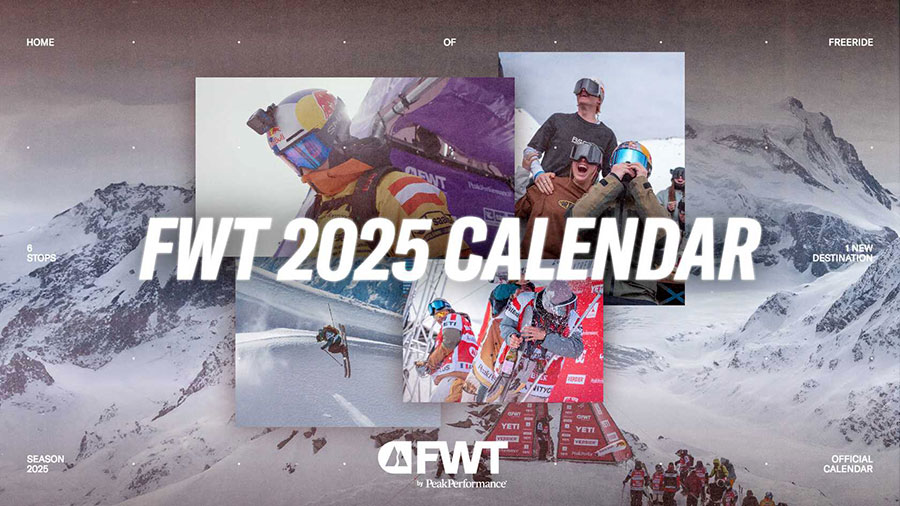
Six epic stops await in 2025, including the debut of Val Thorens Pro, as Andorra prepares to host the inaugural FIS Freeride World Championships in 2026 ∙Six stops on the FWT 2025, kicking off in Baqueira Beret, Spain ∙Baqueira Beret renews its partnership with the Freeride World Tour until 2027 ∙Val Thorens makes its debut as the Tour returns to France for the first time since 2017 ∙Andorra to host the first-ever FIS Freeride World Championships in February 2026 to be formally awarded by FIS Council on October 23, 2024 VERBIER, Switzerland – October 3, 2024: The FIS Freeride World Tour by Peak Performance returns for an adrenaline-charged 2025 season featuring six premier stops across Europe and North America, kicking off in Baqueira Beret, Spain, which has renewed its partnership with the FWT until 2027. The season also includes the highly anticipated return to France with a brand-new stop in Val Thorens. Additionally, looking ahead to 2026, the FWT is thrilled to announce the first-ever FIS Freeride World Championships, taking place in Andorra from February 1-6, 2026. These Championships will be a historic milestone for the sport, showcasing freeride on the world stage. As the FWT embarks on its 18th season, athletes will compete across six epic events, with their top four results out of five counting toward qualification for the YETI Xtreme Verbier by Honda Grand Finale. The anticipation is building for this intense competition, as the world's best freeriders prepare to test their mettle on some of the most challenging terrain in the world. What's in store for the FWT 2025: Stop 1: Baqueira Beret Pro – January 18-23, 2025 The 2025 season kicks off at Baqueira Beret, nestled in the heart of the Spanish Pyrenees. Recently extending its partnership with the FWT until 2027, Baqueira Beret has cemented itself as a fan-favorite stop, known for its lively atmosphere and passionate local crowd. The competition takes place on the renowned Tuc de Baciver face, offering steep pitches, technical rock drops, and dynamic freeride terrain that will challenge riders' creativity and skill. As one of Europe's premier freeride destinations, Baqueira Beret consistently delivers exhilarating performances, setting an intense tone for the season. 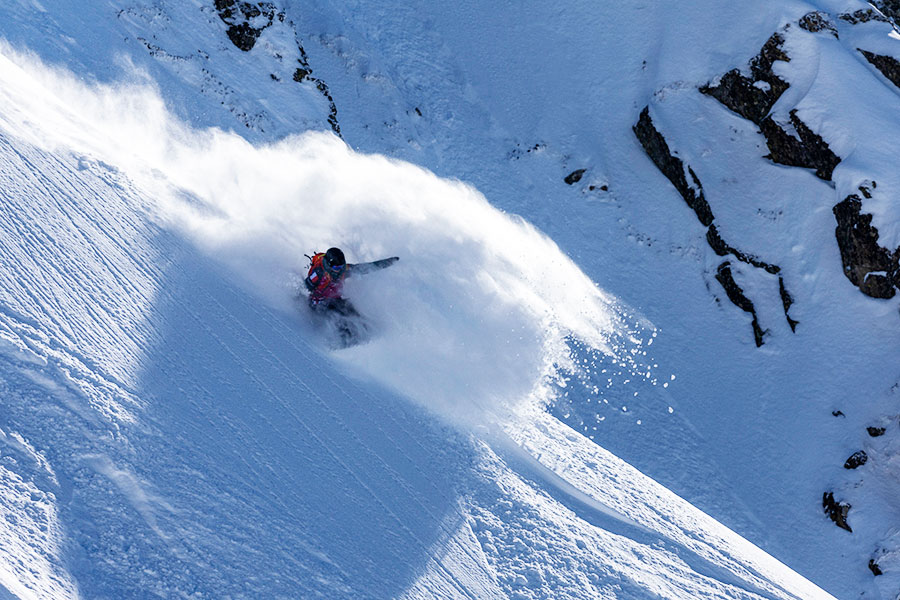
Baqueira Beret, FWT 2023, photo © Freeride World Tour / Jeremy Bernard Stop 2: Val Thorens Pro – January 27 – February 1, 2025 (New Stop) For the first time since 2017, the FWT returns to France with the debut of Val Thorens. Nestled in the world-famous Les Trois Vallées ski area, Val Thorens offers an exciting new challenge to the riders, with the iconic Cime Caron towering over the resort. Known for its steep and technical terrain, Val Thorens promises dramatic action as riders tackle the couloirs, ridgelines, and wide-open freeride terrain that the area is famous for. This first-time stop on the Tour will provide plenty of excitement as athletes battle for early-season points.
Stop 3: Kicking Horse Golden BC Pro – February 7-13, 2025 The FWT then crosses the Atlantic to Kicking Horse, located in the rugged Purcell Mountains of British Columbia, Canada. Renowned for its deep snowpack, steep terrain, and the legendary Ozone face, Kicking Horse is one of the most technically demanding stops on the tour. Riders will need to navigate cliff drops, tight lines, and vast powder fields, making this stop a true freeride battleground. With its mix of challenging terrain and massive features, Kicking Horse consistently pushes athletes to the limit. Stop 4: Georgia Pro – February 23 – March 1, 2025 The Tour then returns to the untamed beauty of Tetnuldi in Georgia's Caucasus Mountains. This stop has rapidly gained recognition as one of the most exhilarating venues on the circuit. The competition takes place on the Khakhiani face, featuring 350 meters of vertical descent, steep pitches, and natural obstacles that challenge athletes to display their finest freeride skills. Known for its vast powder fields and remote allure, Tetnuldi continues to captivate both athletes and fans, delivering action-packed freeride experiences against the stunning backdrop of the Caucasus. 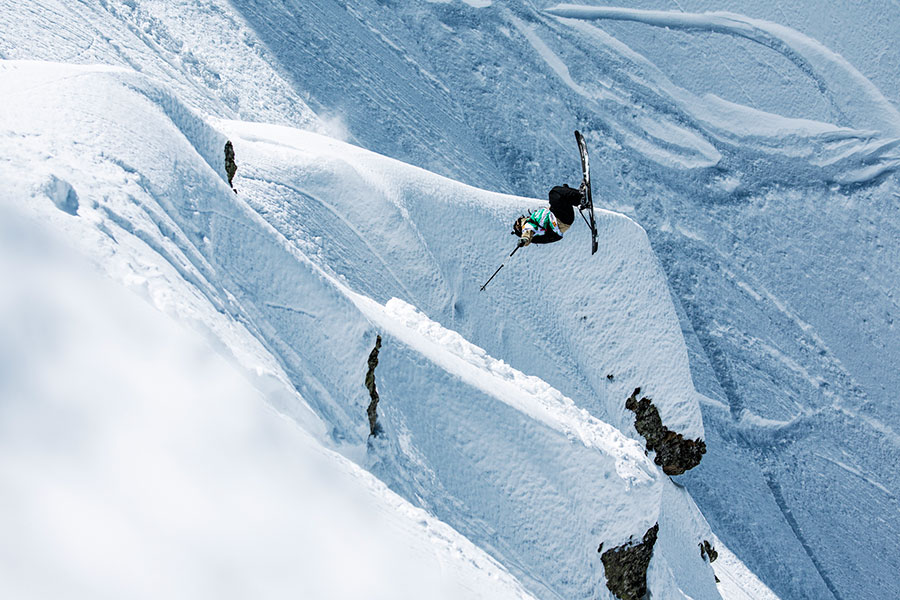
Georgia Pro, FWT 2023, photo © Freeride World Tour / Jeremy Bernard Stop 5: Fieberbrunn Pro – March 8-13, 2025 The pressure mounts as riders head to the Wildseeloder in Fieberbrunn, Austria, for the final event before the cut. Known for its intimidating slopes and complex lines, Fieberbrunn is one of the most revered stops on the Tour. Riders will need to lay down their best line on the steep and technical terrain, which has been a proving ground for freeriders since 2011. With the cut looming, the stakes will be higher than ever as riders battle for their place in the Grand Finale at Verbier. YETI Xtreme Verbier by Honda – March 22-30, 2025 The Freeride World Tour culminates at the legendary Bec des Rosses in Verbier, Switzerland, the most prestigious and challenging stop of the season. Celebrating its 30th anniversary in 2025, the YETI Xtreme Verbier has become synonymous with freeride excellence. Rising to 3,223 meters with a 600-meter vertical drop, the Bec des Rosses is known for its extreme pitches exceeding 50 degrees and complex technical lines. Only the top riders of the season will qualify to compete at Verbier, where the stakes are highest, and the ultimate freeride champions will be crowned. The intense competition on the Bec's treacherous face consistently delivers some of the most memorable and high-risk performances in the sport, solidifying Verbier as the crown jewel of the Freeride World Tour. Making History: The First Freeride World Championships – February 1-6, 2026, in Andorra In addition to the 2025 season, the Freeride World Tour is excited to announce the first-ever FIS Freeride World Championships, to be held in Andorra from February 1-6, 2026. Andorra has long been a top-tier freeride destination, and this event will elevate the sport to new heights as the world's top freeriders gather to compete on a global stage. The qualification system for the event will be announced in December 2024, with a formal award by the FIS Council on October 23, 2024.
Don't Miss a Moment Follow the Freeride World Tour live at www.freerideworldtour.com, where every stop will be broadcast. Stay connected through our social media channels for behind-the-scenes content, rider interviews, and more. The countdown to the 2025 season has begun, and the world's best freeriders are ready to deliver unforgettable performances. About FWT FWT Management SA is based in Verbier, Switzerland, and has been organizing premier sports events globally in mountain resorts since 1996. The company founded the Xtreme Verbier, an iconic event in freeride skiing and snowboarding and, in 2008, it turned this single competition into a prestigious series of worldwide events, called the Freeride World Tour (FWT). The company has since grown to include multiple competition series that fall under the FWT brand – including FWT Challenger, FWT Qualifier and FWT Junior – with events across all formats taking place in Europe, North America, South America and Oceania. Since December 2022, FWT is part of the International Ski and Snowboard Federation (FIS). Discover more at www.freerideworldtour.com About Peak Performance Born in the Scandinavian mountains out of a love for skiing in remote, untouched terrain, our passion for adventure and nature runs deep. Our purpose is simple: we bring the freeride spirit to the world. As for our products, they all have the same purpose – empower the freedom to be adventurous and follow your own line. Whether it be horizontally or vertically, on skis, by bike, or on foot, they offer a balance of style and performance. Our Scandinavian heritage is ever present and our commitment to doing better things in a better way is our never-ending responsibility. For more information, please visit www.peakerformance.com |
|
Snow Reports by e-mail - New Ski Resorts
Started by Admin in Snow Forecasts and Snow Reports, 78 Replies, discussing Morillon and Sölden |
|
|
Pending an imminent (and major!) refresh of our forecasts, we realise we've got a bit of a backlog on the requests here, but as of today the following are added;
Is also done (thanks for the prompt)
Is available under France. Enjoy! For anyone reading who's not sure what this is all about... sign-up on J2Ski, login and visit your Profile. You can add the ski areas you're most interested in to get forecast updates and powder alerts, etc. |
|
|
Ski areas closing in the southern hemisphere, glacier areas already open in Europe, and others preparing to open in the northern hemisphere.
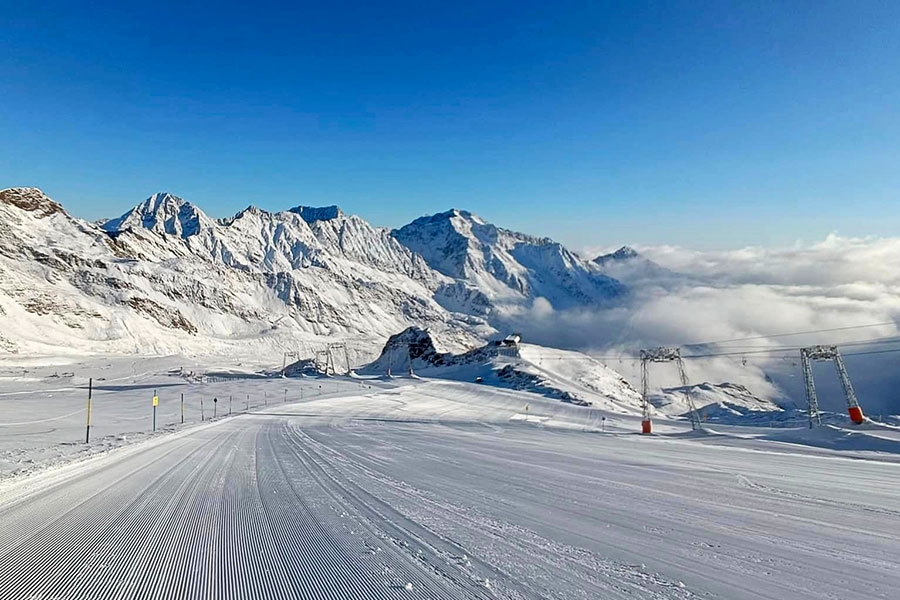
Stubai Glacier, Austria, now open for skiing... Where to Ski in October 2024 We're at the changing of the seasons in both the northern and southern hemispheres. Temperatures have been rising and the snowpack melting fast in most ski regions of Australia, New Zealand and South America. More than half of the southern hemisphere's ski centres have already closed with those still open having reduced their open terrain in most cases and the majority of those still operating planning to close the first weekend of this month, although a few will go a week or two later into October. Of course, it's the opposite picture in the northern hemisphere with temperatures falling and anticipation building for the season ahead. A big early snowfall in the Alps in mid-September led several glacier ski areas to start their 24-25 seasons early and as a result we expect the number of resorts open in the northern hemisphere to overtake the number open in the southern from next Monday October 7th, with a few more opening each weekend from then on. Nowhere is open yet in North America but there have been some early snowfalls here too, raising anticipation levels and it's likely one or more centres will open in the latter half of the month. Europe Alps There was a good snowfall in the Alps about a third of the way into September which deposited 50cm of snowfall on glaciers and seemed to mark a change to more wintery weather that continued up high for much of the latter half of last month. As a result, we went from just two glacier areas at the start of September to almost double figures as we start October, with several resorts opening early thanks to the snow. Austria is leading the way with a re-opened Hintertux offering the most open terrain in the northern hemisphere at the start of the month, about 25km of slopes. The Pitztal, Solden and Stubai glaciers are also already open and Kaunertal plans to join them on the 4th, followed by the Kitzsteinhorn on the 12th and then the Molltal glacier on the 26th. In Switzerland, Saas Fee and Zermatt are open and expected to be joined by the Diavolezza Glacier near St Moritz on the 19th. In Italy, Passo Stelvio and Val Senales have opened and the link to Zermatt's glacier from Cervinia should re-start on the 26th. There's currently nowhere open in France and nowhere expected to open in October with Les 2 Alpes and Tignes both having given up attempting to do so. Scandinavia Norway's Galdhoppigen glacier, Scandinavia's highest ski centre, re-opened in late September and should remain so throughout October, it's already had some fresh snowfall. Finland's season is due to start on October 3rd with Levi and Ruka opening a few kilometres of slopes each, spreading snow stockpiled through summer back out on the slopes ahead of the first snowfalls, last year those were within days of opening. Finally, Sweden's Kåbdalis and Tarnaby should open from the 26th for the final weekend of the month. North America October is normally the month when North America's ski season begins, but at the start of the month no one really knows where it will be and precisely when – all depends on where gets coldest quickest for snowmakers to make enough snows to form a base, with any natural snowfall a bonus. More often than not that's one of the high centres in Colorado, but past years have seen resorts in California, the Pacific Northwest, Vermont on the east coast and even in the Midwest manage to get their lifts turning first. There have been a few early snowfalls on most North American mountain chains, especially in the West (and as far south as Arizona) with ski areas around Banff – which officially have the earliest named season opening dates at the start of November, seeing the most so far. Prime candidates for October opening, with their snowmaking systems ready to go and past history of opening in October, are Colorado's Arapahoe Basin, Copper Mountain, Keystone, Loveland, Silverton and Wolf Creek. Southern Hemisphere The southern hemisphere's 2024 ski season is winding down fast with Australia's biggest resort Perisher and Tasmania's much smaller Mount Mawson, the last centres to close - in the final week of September. Most centres in Argentina, Chile and New Zealand have also either closed already or are due to on the first Sunday of October. Around 10 ski areas across those three countries will carry on for a further one or two weeks. In the Andes, Chile's Valle Nevado has extended its season by a fortnight so far, to October 20th and some New Zealand centres including Cardrona, Mount Hutt and The Remarkables are targeting either that weekend or the one before too. |
|
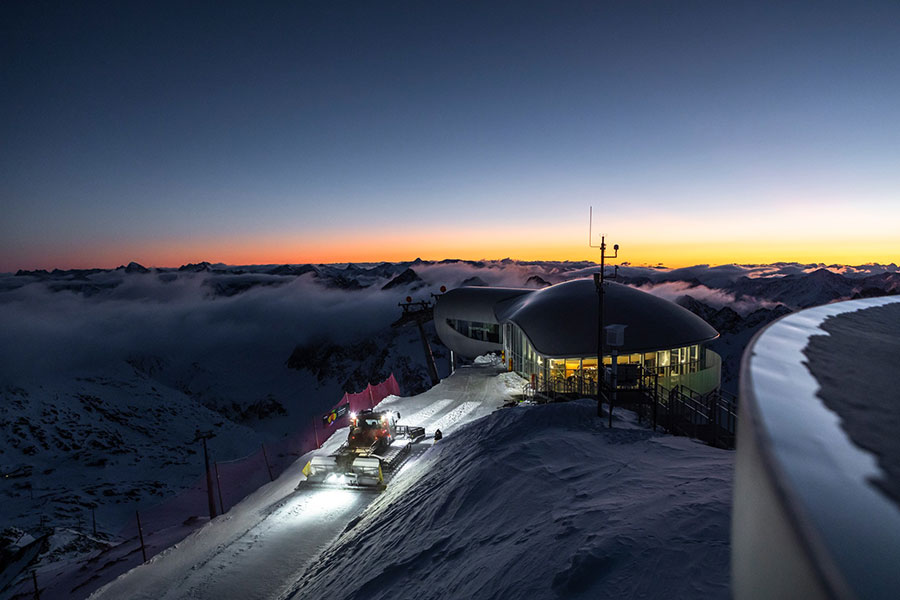
Pitztaler Glacier, Austria, preparing to open on Saturday (28th September). A handful of European alpine resorts will be open by the weekend, Chilean ski areas have extended their winter and Australia is done, while parts of NZ get an end-of-season boost. The Snow Headlines - September 26th - Chile's Valle Nevado announces a two-week season extension. - Australia's 2024 season is over. - Solden opens a week earlier than expected. - Ski season resumes at Galdhopiggen in Norway. - Fresh snowfall on Western North American peaks, although nowhere open yet. - One week to the start of the season in Finland. - Number of ski areas open in the Alps more than doubles from 3 to 8. - Snow in Southern Africa three weeks after season ends. 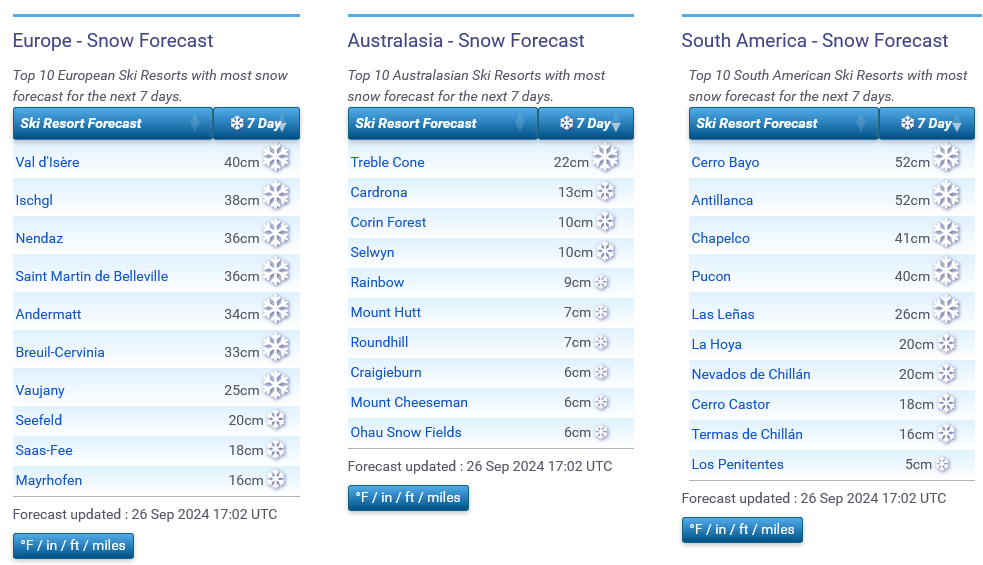
Light pre-season snow coming in for the Alps, and some late-season cover for the southern hemisphere
World Overview The seasons have clicked over from summer to autumn in the northern hemisphere and winter to spring in the southern by the astronomical measure as well as the meteorological, so we can now say it's full autumn/fall or spring - depending where you are. In the northern hemisphere, autumn has brought colder temperatures and wintery weather, with more snow on alpine glaciers and up in Scandinavia as well as Scottish peaks. As a result, we're up from three to eight centres open in Europe compared to a week ago and will be in double figures from Saturday. North America saw some snowfall on western peaks last weekend but it's been dry and sunny since with nowhere close to opening there yet – although things often change quickly in October. It's season wind-down time in the southern hemisphere and it's completely over in Australia, a little prematurely but similar to last year when hopes of making it to October also faded. It joins Lesotho in Southern Africa as the second of the five southern hemisphere ski nations to end its 2024 seasons. Ironically there was an unusually heavy snowfall in South Africa earlier this week, more than three weeks after the largely snowless season ended in the region. Many centres in the other southern hemisphere ski nations have had fresh snowfall too, but most are closing this weekend or next with just a handful soldiering on later into October. Most have seen rising temperatures, diminishing bases and reducing open terrain - as normal - for the final weeks of the season. Southern Hemisphere Australia There was some fresh snowfall in Tasmania at the weekend which led to the small Mount Mawson ski area there opening a few runs. However, the warm and sunny daytime weather has continued to dominate conditions otherwise, with rain and strong winds thrown into the mix over the past few days. The last mainland area open, Perisher, decided to close on Wednesday, abandoning their plan to continue through to Sunday. New Zealand New Zealand's weather continues to move between extremes, with another mix of snow, rain, wind and the odd perfect, still, blue sky, fresh snow day thrown into the mix over the last week. Daytime temperatures are climbing gradually though, despite overnight lows still dropping below freezing. For some ski areas, it's an ongoing battle to stay open and several more plan to close after the coming weekend. Cardrona and Mount Hutt are among those aiming for a few more weeks and there was good news on the North Island at last for Turoa and Whakapapa which had significant fresh snowfall this week - and managed to open a bit more terrain for their final weeks as a result, in Whakapapa's case more than they've been able to offer all season. Argentina Argentina's season is drawing to a close with most of the country's centres expected to end their seasons this coming Sunday or the one after. The past week has been predominantly dry with lots of sunshine and daytime highs above +10C at many resorts. That said, overnight lows continue to be sub-zero so the snowpack keeps freezing and bases haven't dropped much in most areas, although the amount of terrain available has. Cerro Catedral, which had 100km of its 120km slopes open until last weekend, has dropped to 20km for the final weeks. There's nothing too exciting in the forecast, more warm afternoons and rain showers are now more likely than snow. Chile Chile's season is winding down fast with mostly dry weather and warm afternoon conditions. Most centres are reporting their snow depth down by 20-40% from a few weeks ago with some also closing sizable parts of their skiable terrain. In fact, a few smaller resorts ended their 2024 seasons altogether last weekend and many more will close this weekend or the one after. The news isn't all bad for Chilean skiers with one of the largest ski areas, Valle Nevado, announcing a fortnight's season extension through to the latter half of October and another big name, Portillo, still reporting its slopes 100% open for the final week of winter there. Temperatures are still getting well below freezing overnight but climbing into double figures above zero (C) by the afternoon most days now. Europe After the snowy weather a fortnight ago things have been calmer in the Alps, although there has been more snowfall reported on high slopes, most recently in the south and east with open Italian glaciers Passo Stelvio and Val Senales reporting fresh cover. Solden joined the Stubai in opening early last weekend and with the country's highest area Pitztal also opening this weekend and Hintertux re-opening too, Austria now has four centres open – half of Europe/the northern hemisphere's total. Kaunertal and the Kitzsteinhorn, as well as Molltal, are due to open next month, the first in just over a week's time. You can also ski at Saas-Fee and Zermatt in Switzerland, although the cross-border link from the latter's glacier down to Cervinia in Italy will remain closed for another month. Things are starting to happen in Scandinavia too with the region's highest slopes at the Galdhopiggen summer ski area reopening with freezing temperatures and snow showers. Finland's Ruka and Levi also plan to start their 7-month long seasons at the end of next week, using snow stored through summer and now spread back out on the slopes. North America There's been more snowfall, last weekend, across western North America with the first snow reported on mountains in Utah as well as more snow in California, Alberta, BC and even a second fall for Arizona. Since then the past few days have been a little warmer and mostly sunny and that remains the forecast for the coming days so we still seem a little way off from the start of snowmaking anywhere. |
|
Snow Reports by e-mail - New Ski Resorts
Started by Admin in Snow Forecasts and Snow Reports, 78 Replies, discussing Morillon and Sölden |
|
That's in the list below Stuben, due to the umlaut on Sölden |
|
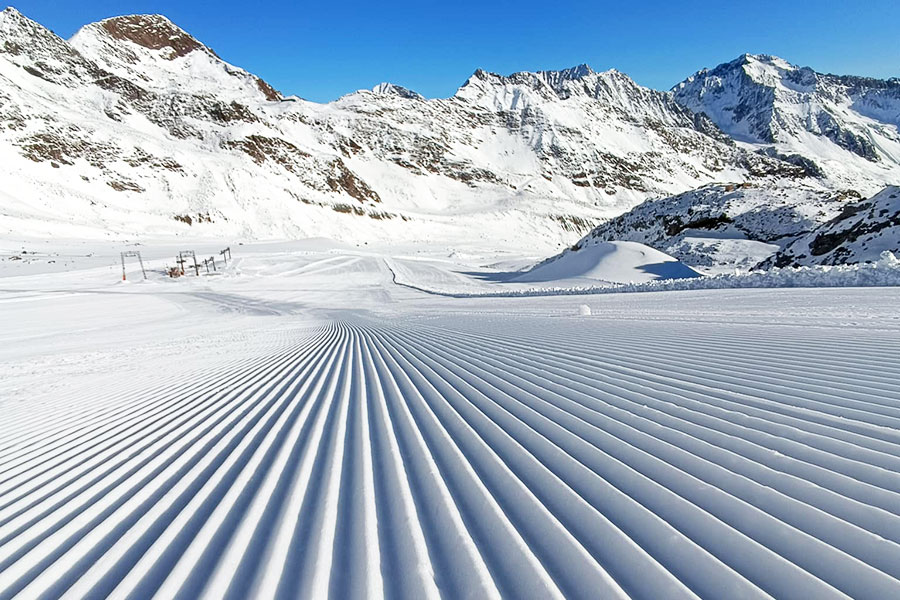
Stubai Glacier, Austria, opening tomorrow(Friday!) after last week's heavy early snow. Heavy snow (and flooding) arrives for parts of Europe, while New Zealand and South America get late season boosts with snow falling in the final weeks of their seasons. The Snow Headlines - September 19th - Stubai announces early opening - this Friday! - First snowfall ahead of 24-25 season in the Pyrenees. - Heavy September snowfall in the Alps, down to low levels in places. - Heavy snowfall in New Zealand. - Only two centres still open in Australia. - More Alpine glaciers are preparing to open. - Forest fires threaten ski areas on the US West Coast. 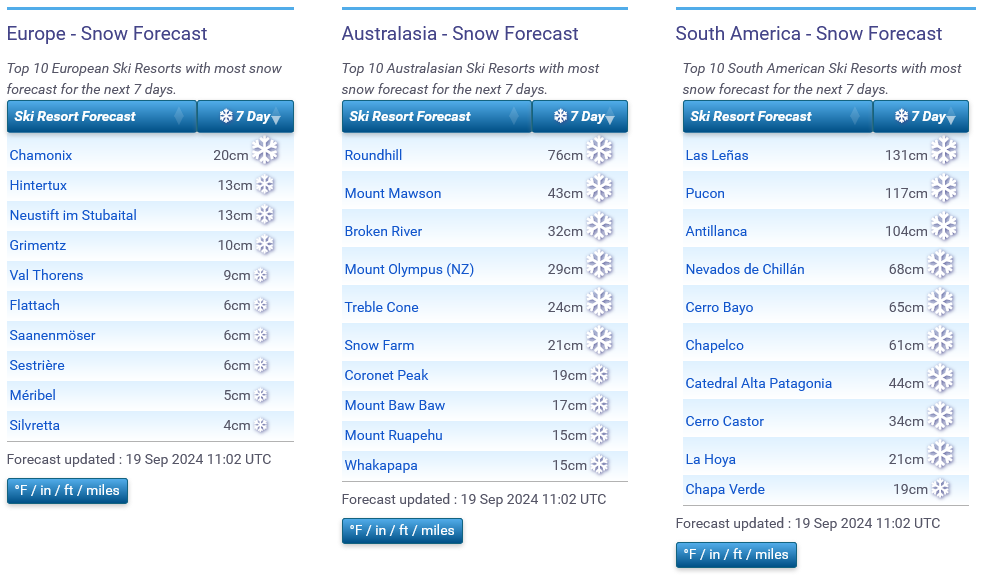
Decent late-season snow forecast for New Zealand, Argentina and Chile
World Overview The big news in the ski world this past week was the amount and extent of snowfall in Europe in the latter half of last week. Along with sizable falls up above 2,500m, which isn't unusual for late summer/early autumn, there was heavy, wet snow down to low levels, disrupting summer operations, particularly in the Austrian Alps. That's allowed at least one Austrian glacier ski area to start their season early, this coming weekend. The European snow fell over a very wide area too including Slovenia in the east and the Pyrenees to the west. In North America, the ski news was unfortunately more of forest fires threatening resorts than fresh snowfall, but high-altitude resorts in the Rockies are prepping their snowmakers to begin operations. The season continues to wind down in the southern hemisphere with Australia the most 'wound-down' having now only the largest resort Perisher, and one of the smallest Tasmania's Mount Mawson, left open. New Zealand areas by contrast have had a boost with a good fall of snow over the last week and most centres in the Andes remain open. Southern Hemisphere Australia With Charlotte Pass, Falls Creek and Thredbo closing early last weekend, only Australia's largest area Perisher remains open of the big players, albeit with thin cover left and less than 10% of its slopes still skiable. Temperatures did actually dip a little this last week and there were some light snowfalls. Ben Lomond in Tasmania even reported that it was re-opening for weekend sledging, if not skiing as a result, but the other Tasmanian ski centre, Mt Mawson, has a tow still running for skiers. Perisher hopes to stay open to the start of September but with afternoon temperatures continuing to be warm that remains to be seen. Overnight lows are still dipping below freezing. New Zealand It was one of the better weeks of the past month in New Zealand despite the fast-approaching end of the season. The main boost was a 20-40cm snowfall in the final days of last week which really transformed conditions after the spells of warm weather, rain and gales in recent weeks. The past week has seen several blue sky powder days after the snowfall. Coronet Peak, Cardrona and Mount Hutt appear to be in the best shape, with bases up to 2 metres up high and 100% of their terrain still open. Some smaller resorts are struggling with thin cover, and strong winds continue to cause closures. Mount Ruapehu's Turoa and Whakapapa ski areas remain hard hit with very little open so it is not looking good for their usual October operations. Argentina Most of Argentina's ski areas remain open although it's the final week or two for many. It's been a mostly dry week, frequently sunny and although overnight lows continue to dip just below freezing, daytime highs have reached +10C to +15C which is of course impacting snow cover. Most centres still have most of their slopes open, if down a little on a week ago. Catedral near Bariloche still has the most open in the world, down a little from 100km to 94km of slopes. Chapelco also still has the world's deepest reported snowpack, also down slightly on a week ago, at 3.2m. Chile A definite end-of-the-season feel in Chile with temperatures reaching the high double digits above freezing (Celsius) in the afternoons at some resorts. However, overnight lows on high runs continue to dip below freezing for freeze-thaw conditions so it's not a non-stop meltdown. It has been largely dry and frequently sunny over the last week, although rain/snowfall is expected for the remainder of this week. Base depths are dropping a little with the warmth but most centres remain fully open, Valle Nevado for example posting a 1-2.5m base depth and 100% of its lifts turning and runs open. Portillo has a 70-140cm base, down from double that at the height of winter, but also reports its slopes 100% open. Europe European ski areas had an exciting end to last week with over a foot of fresh snowfall above 2,500m and snow right down to valley floors, particularly noted in Austria where ski resorts like Lech posted PR pics and videos of impatient skiers looking optimistically at the snow on the resort's streets. Stubai Glacier announced on Monday that, after half-a-metre of late summer snowfall, it's starting its season weeks earlier than expected, this coming Friday 20th September. The snowfall covered a wide area including resorts in the Dolomites, as far east as Slovenia's Julian Alps and there was a dusting in the southwest too in the Pyrenees. It has since warmed up in valleys so the interruption to late summer mountain biking and hiking operations is about gone now, but temperatures remain in the -5C to +5C range up above 2,500m with more snow showers, albeit lighter ones, forecast for glaciers. Currently, it remains Saas-Fee and Zermatt open in Switzerland with the link to Zermatt's glacier from Cervinia currently closed, perhaps a little cruelly to Cervinian skiers given the fresh snow at Zermatt! However Italy's Passo Stelvio is open and Val Senales is scheduled to open for its 24-25 season this weekend, although possibly only for race team training initially. Austria's Hintertux had not yet re-opened at the time of writing despite getting a foot of fresh snow at the weekend, but that could change at any time. Two more Austrian areas, Pitztal and Solden, plan to start their 24-25 seasons in a week's time. Scandinavia saw snowfall too, in its case from the same Arctic air that moved down over the UK. Many centres there posted images of light snow coverings. Currently, the only area that should be open, the Galdhopiggen glacier, remains on hold. The two major Finnish ski areas Levi and Ruka plan to start their 24-325 seasons in a fortnight's time thanks to their snow farming efforts. North America In North America, ski areas in Colorado have continued preparing snowmaking systems as cold temperatures overnight have been more consistently dipping below freezing. There remains nowhere open across the continent at present with the first named opening date at Mount Norquay, Banff, Canada still six weeks away on November 1st. There has been more snow dusting high peaks over the last few days, with a second coating for Californian peaks and a first for Utah this autumn/fall. Unfortunately, ski areas have also been in the news for the wrong reasons this week with Oregon's Mount Bachelor and Mountain High and Mount Rose in California all threatened by forest fires. |
|
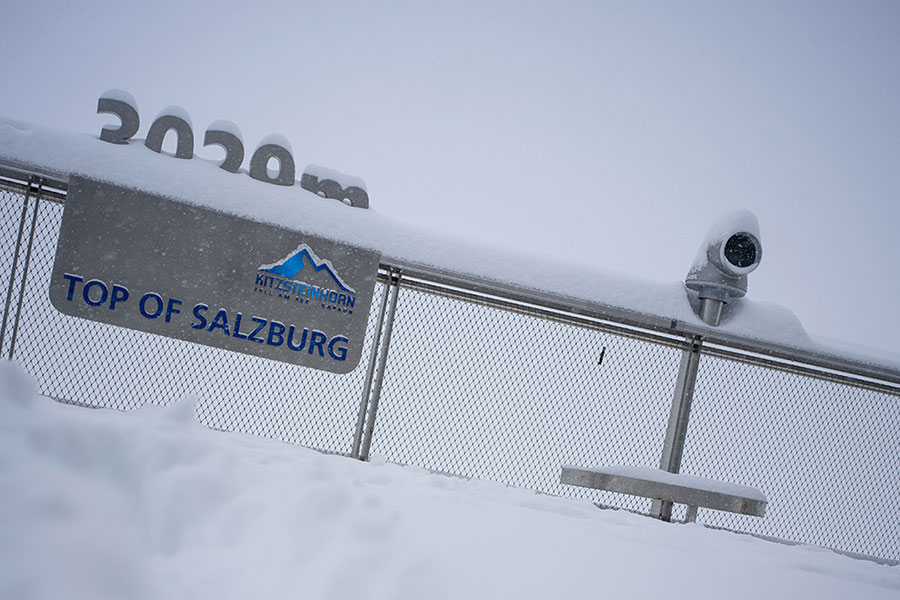
Early snow for the Kitzsteinhorn, Austria, opening 12th October! Heavy snow (and rain) forecast for the eastern Alps, though it may not last, while the southern hemisphere winds down into spring. The Snow Headlines - September 12th - 30cm accumulation reported on Zermatt's summer ski slopes. - Fresh snow in New Zealand, along with more gale-force winds. - First fresh snowfall of autumn Scottish and Scandinavian slopes. - All but one of remaining Australian resorts to close by Sunday. - Scottish ski instructor killed in avalanche in Argentina. - More snowfall on high slopes in the Alps, reaching Dolomites too. - First flakes reported in Eastern North America. 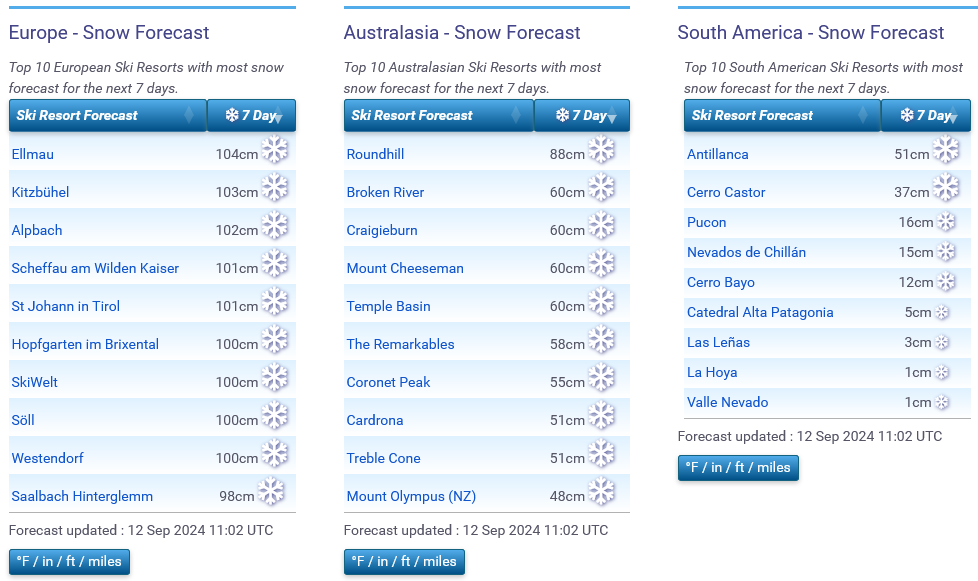
Heavy early snow forecast for the Alps
World Overview The change in seasons is becoming more apparent in both the northern and southern hemispheres as we move further into September and are now just a week away from the start of astronomical spring or autumn, depending on where you are. The change in the meteorological measure of the seasons already happened a fortnight back! In the northern hemisphere the prolonged heat is finally beginning to lose its grip, with cooler temperatures and snowfall on high slopes in the Alps and the Colorado Rockies. There has also been snow on high peaks in Scandinavia, Scotland, North-eastern North America and the Dolomites over the past few days. In the southern hemisphere it is ever warmer afternoon temperatures that are hitting snow cover. Australia hardest, where only one area looks set to remain open next week. To a lesser extent New Zealand where the first centres have announced they're shutting down snow operations until 2025 too. The most terrain and deepest snow remains in South America but daytime highs are getting warmer in the Andes as well and though everywhere remains open for now, there's a definite end-of-season feeling. Southern Hemisphere Australia Australia's 2024 season meltdown has continued with three more centres – Charlotte Pass, Falls Creek and Thredbo all announcing an early season end, either this coming Friday (13th) or Sunday 15th of September. With other centres having already ended their seasons, from Monday only Perisher will still be operating, and it reports that about 90% of its slopes are closed due to the warm sunny temperatures. It's been almost relentlessly sunny with overnight lows still dipping 4C to 8C degrees below freezing but daytime highs topping +10C continuing to thaw the remaining snow fast. New Zealand New Zealand ski areas have had yet another roller-coaster week of gales, rain, warm spells but also snowfall at times. At the time of writing things are on a high as there's been 10-20cm of fresh snowfall in the past 48 hours and Thursday was a blue sky day with sub-zero temperatures and only a small problem with the gales, so most centres reported superb conditions. Wet and windy weather on other days has led to one centre, Temple Basin, saying they can't keep going and are ending their 2024 season. On the North Island Whakapapa and Turoa continue to struggle with their season-long issue of not enough snow and they have only very limited terrain open. However, on the South Island Mount Hutt is still 95% open with the snow over 2m deep. Argentina It has been a largely dry week in Argentina with fairly typical spring freeze-thaw conditions as temperatures yoyo between -10C up high under clear skies overnight to +10Cs at resort bases. There's a definite 'end of the season' feeling from that, but at the same time base depths are holding up, particularly at Corralco (with the world's deepest base of 3.3m up high). Most centres have 70-100% of their slopes open with the 95km at Catedral near Bariloche remaining the most in the world for a single resort of currently open areas. Chile Daytime temperatures are starting to regularly hit double figures above freezing at the mountain bases in Chile, although overnight lows are well below freezing up high, so that's freeze-thaw conditions and very much spring underway, with some centres likely to announce season ends over the next few weeks. Base depths are reported to be holding up though and bigger resorts like Portillo and Valle Nevado remain fully open. Europe There's been a definite shift in the seasons this week in Europe with an Arctic front moving down from the north bringing snowfall to mountain peaks in Norway, Finland, Sweden and Scotland. Colder weather in the Alps has also brought substantial snowfalls to glaciers and high slopes in the Alps, and that's extended further south and East into the Dolomites too. There has also been snowfall down to lower levels, with ski areas like Kitzbuhel reporting a covering of snow. Three of the four glacier areas that are trying to stay open are currently reported to be operating although one of them, Saas-Fee, was cut off by a landslip for much of the past week and the only access in and out was an expensive helicopter taxi. The road has now re-opened however. In nearby Zermatt, the plan to have year-round access from Cervinia also appears to have been quietly shelved with the link currently closed until late October. Skiers on the Swiss side can still access about 11km of slopes open there with fresh snow cover. Skiers in Italy can still ski Passo Stelvio which reports more slopes open. The glacier at Val Senales, which was closed last autumn as a cable car was renewed, reports it will open from next weekend, although possibly only for race team training. Austria's formerly year-round Hintertux glacier has now been closed for more than a month but is reviewing its closure daily and will re-open whenever conditions are good enough. That's a similar position to Norway's Galdhopiggen glacier centre and it's now only three weeks until Levi and Ruka in Finland are due to open for their 7-month 24-25 seasons, using snow stored through last summer and spread back out on their slopes. North America The first snow – kind of – was reported on east coast mountains in New York State at the weekend, an almost unnoticeable dusting, but skiers noticed! That followed the more significant whitening of higher mountains in the Colorado Rockies. Here, temperatures are regularly dipping a degree or two below freezing each night, although the weather is back to predominantly sunny. High resorts hoping to open next month like Arapahoe Basin and Keystone have been busy testing their snow-making equipment. Nowhere is currently open in North America however. |
|
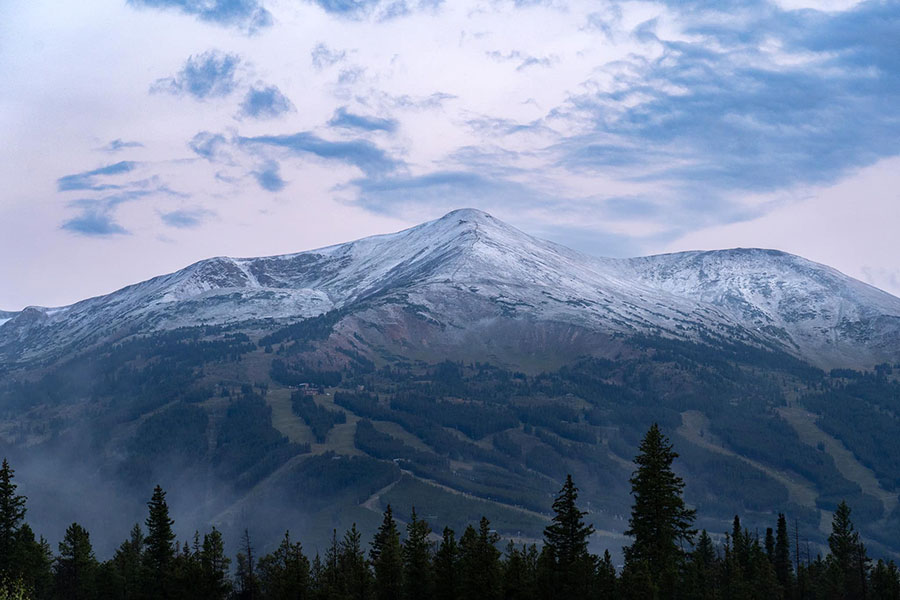
An early dusting for Breckenridge, Colorado, USA We're getting that autumn feeling; first snows high in the Alps and the Rockies, as spring arrives and the ski season winds down in the southern hemisphere. The Snow Headlines - September 5th - Fresh snow falls on high slopes in the Alps. - Meltdown for Australia's 2024 season, most resorts close early. - August snowfall in Arizona. - More heavy snowfall in Argentina. - September snowfall in the Rockies as Colorado resorts ready snowmaking equipment. - South Africa's season ends on schedule at Afriski in Lesotho. 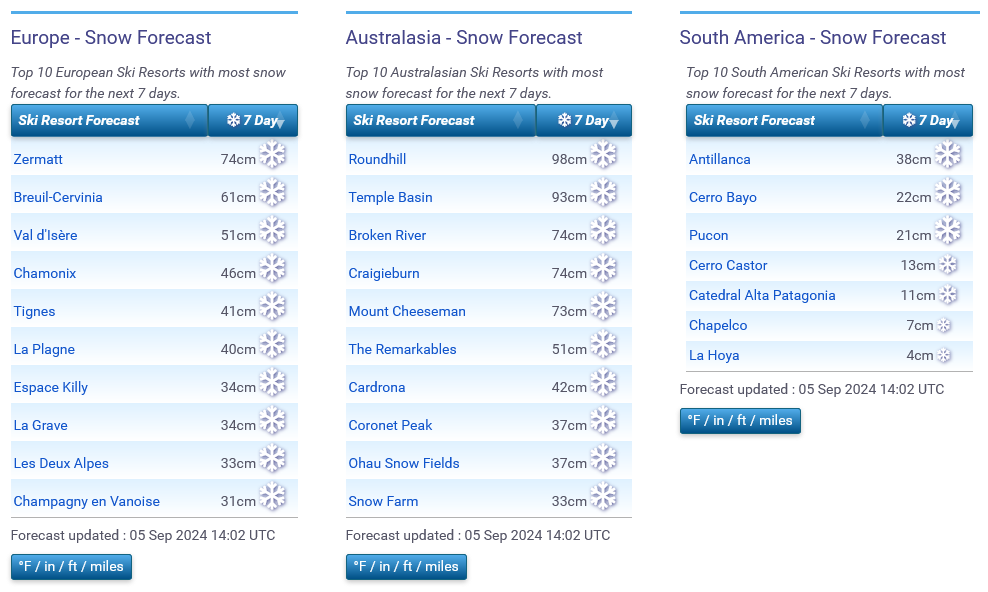
Early autumn snow forecast for Europe, and late season top-ups for New Zealand
World Overview The start of meteorological springtime in the southern hemisphere has seen more snowfall across the region's ski nations, but severe gale force winds and mild temperatures bringing torrential rain before the snow have also been factors for New Zealand and Australian ski areas. In the latter's case, it led to more Aussie areas announcing they'd be closing at short notice so now more than half have closed - up to a month earlier than planned. It's a better picture in the Andes where there's been heavy fresh snowfall; and base depths as well as open terrain are all holding up. In southern Africa, the 2024 season ended on Sunday at the only open ski area, Afriski in Lesotho. In the northern hemisphere, Sunday saw the start of meteorological autumn/fall (and of September) which should see the number of ski areas open, (currently, officially, four) more than double by the end of the month. The four glacier areas currently open in the Alps have continued to battle warm temperatures, but there was good news – kind of – as we complete this weeks report with the first snows of September spotted above 3,000m in the western Alps. 'Kind of' because it's the cold end of a torrential rainstorm that's brought flooding to some valleys. Across in North America nowhere is open at present but there's been fresh snow up high as far south as Arizona and anticipation continues to build for the start of the 24-25 season, hopefully next month. Again, as we complete this week's report Colorado ski areas are posting images of fresh snowfall there. Southern Hemisphere Australia Sadly, the warm August weather has led to more than half of Australian ski areas closing early over the past week. Mounts Baw Baw and Buller closed on Sunday, whilst Selwyn Resort said it's likely to abandon it's hoped-for re-opening. Hotham closed on Wednesday leaving just Perisher, Falls Creek and Thredbo still open of the country's bigger resorts. There were a couple of breaks in the heat over the past week, with light snowfall on Friday followed by an Antarctic blast to start the week which brought a 10-degree dip in temperatures and more snowfall. Base depths have almost halved in a week, however, and the open areas – most of which are trying to hang on until October, now have only fractions of their terrain left open. New Zealand New Zealand has had frequently wild weather all season and this past week has been little different with torrential rain at times with mild temperatures and 100mph gales an even bigger issue. That led to the opening of the Park & Pipe 24-25 World Cup Tour at Cardrona needing to be repeatedly delayed through the weekend. Against all these setbacks there have also been periods of heavy snowfall and even some fresh powder days, it's just hard to know what's going to hit from one day to the next. The big picture is that the country's main ski areas including Treble Cone, Mount Hutt, Coronet Peak and others remain 70-100% open with fairly decent depths for the final month of the season. The exception, unfortunately, is Mt Ruapehu on the North Island where Whakapapa and Turoa continue to struggle with very little open. Argentina It's been a good week for Argentina's ski areas with temperatures staying low and some good fresh snowfalls to start September, with accumulations of up to 50cm reported. It's getting warmer now that meteorological springtime is here but is still dipping way below freezing overnight right down to base levels. Catedral, near ski town Bariloche, continues to post the most terrain open anywhere in the world at present with about 100km of slopes and Corralco has the world's deepest snowpack with 3.3m lying up top. It's looking drier and warmer for the coming weekend. Chile Conditions remain good on the whole in Chile with most areas seeing fresh snow this week and reporting their slopes still fully open, even with the end of their 2024 seasons only a fortnight away in some cases. The Tre Valles area east of Portillo which links the slopes of La Parva, Valle Nevado and El Colorado reports nearly 100km (90%) of the area open and base depths just under 3 metres on upper slopes. The base depth numbers are good at Nevados de Chillan to the south too whilst Portillo reports all slopes still open. Europe It's been another difficult week for the four glacier areas in the Alps that are trying to offer summer skiing. It has been a degree or two cooler and there have even been light snow flurries reported above 3,000m, but overall temperatures are getting 5-10 degrees (Centigrade) above freezing even at that altitude, so the snow is wet and then icy where it does get back below freezing overnight. Thursday afternoon did see more promising, widespread accumulations with Italy's Bardonecchia and Val d'Isere in France posting images of fresh snow above 3000m. However in the next valley there were flooding problems and road closures around Val Cenis. As for the ski areas aiming to be open, Austria's Hintertux remains closed but Italy's Passo Stelvio has re-opened and Saas Fee and Zermatt have each managed to open 8-11km of slopes each, albeit with diminished snow levels. Two more alpine glaciers, Pitztal and Solden, are due to open in three weeks and Levi and Ruka in Finland are also scheduled to open in less than a month, in their cases using snow 'farmed' (stockpiled under cover) from last season spread back out on the slopes, so more consistent lower temperatures will help them all make that happen. North America There's nowhere currently open in North America with the first centres expected to start their seasons from mid-October, if conditions allow. There have now been several late summer snowfalls, between warm spells, on high slopes across the western side of the continent. Ski areas in Alberta have now had multiple early season falls and one novelty last week was a snow shower up high in Arizona on the last day of August. This snow quickly melted again but cheered up skiers looking for signs of winter. Overnight lows in the Rockies are now regularly getting down close to freezing and Wednesday night saw dustings of snow on high slopes in Colorado with Arapahoe Basin, Breckenridge and Keystone amongst those posting images of their mountain tops turning white. |
|